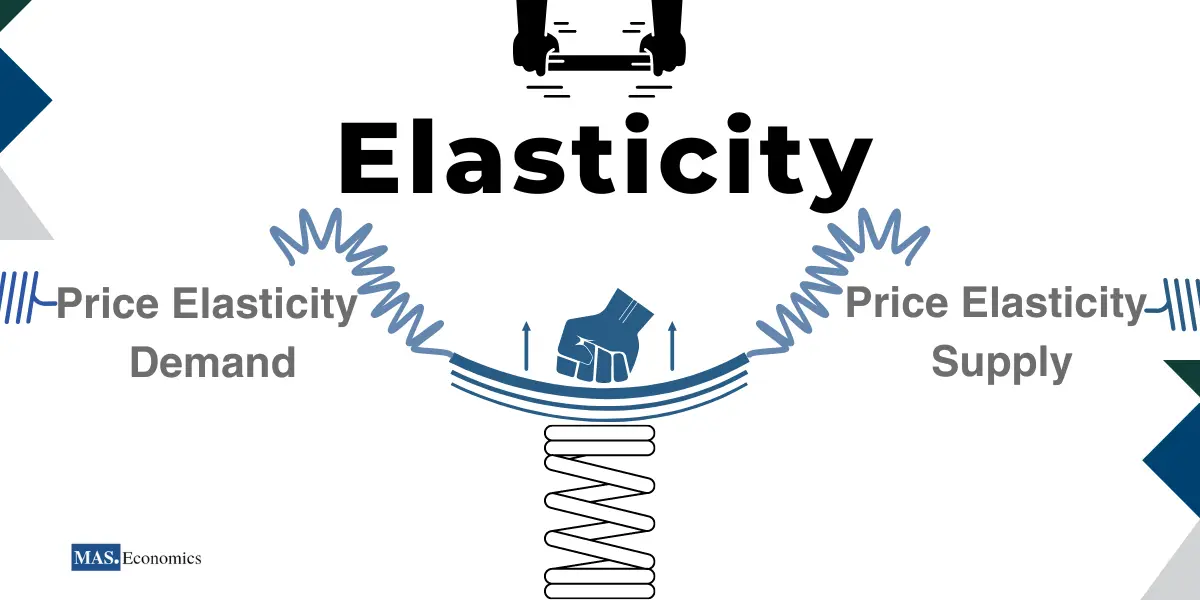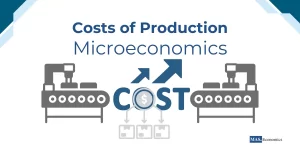Welcome to MASEconomics, your guide to the world of economics. In the previous blog article, we learned about the relationship between price and quantity demanded and price and quantity supplied.
We saw that demand has an inverse relationship with price, and supply has a direct relationship with price.
However, the responsiveness of demand and supply to changes in price can vary. This is where elasticity comes in.
What is Elasticity?
The concept of elasticity is crucial in determining the responsiveness of one variable to changes in another. Specifically, in economics, elasticity is a vital tool for measuring the degree of responsiveness of the quantity demanded or supplied of a good to fluctuations in its price.
How much change in price supplier or demander response depends on their elasticity.
This is correct. The elasticity of demand and supply determines how much change in price will cause a change in quantity demanded or supplied.
For example, a good with elastic demand will have a significant change in quantity demanded and a small price change. On the other hand, a good with inelastic demand will have a slight change in quantity demanded and a small price change.
To illustrate the difference between elastic and inelastic demand, let’s look at the following graph.
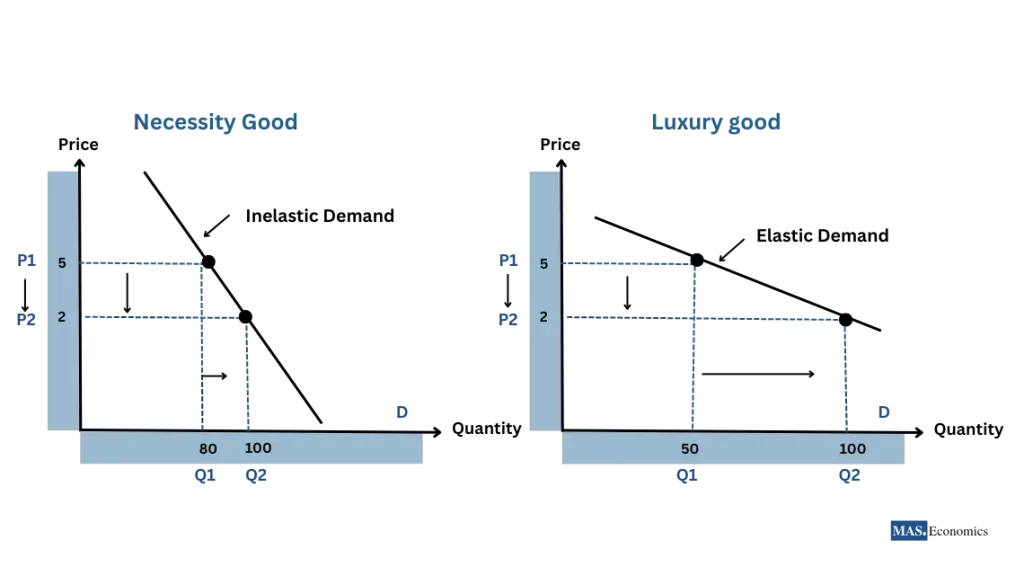
The two curves represent the demand for the two different goods. The steeper curve is the demand curve for the luxury goods. This indicates that the demand for luxury goods is more elastic than necessities.
There are four main types of elasticity in economics:

In this blog, we will learn about these four types of elasticity in more detail.
Price Elasticity of Demand
PED is a crucial metric that determines the responsiveness of a good’s quantity demanded to changes in its price. The calculation involves dividing the percentage change in quantity demanded by the percentage change in price.
The formula for price elasticity of demand is:
PED = \( \frac{\% \text{ change in quantity demanded}}{\% \text{ change in price}} \)
Consider a luxury brand that produces high-end smartphones. At a certain price point, let’s call it \$800, the brand decides to lower the price to \$700. As a result, the quantity demanded increases from 1000 units to 1200 units. Using the formula for PED, we can calculate the elasticity as follows:
\[ PED = \frac{\% \text{ change in quantity demanded}}{\% \text{ change in price}} = \frac{(1200 – 1000)/1000}{(700 – 800)/800} = -1.71 \]
The negative value of PED indicates that the demand for these luxury smartphones is elastic. Consumers are pretty responsive to price changes, which means that a price decrease leads to a proportionally larger increase in the quantity demanded.
The absolute value of PED serves as a compass guiding us through the landscape of demand. It helps us categorize demand into elastic, inelastic, or unit elastic scenarios.
| Degree of Elasticity | Absolute Value of PED | Description |
|---|---|---|
| Elastic Demand | Greater than 1 | A small change in price leads to a large change in quantity demanded. |
| Inelastic Demand | Less than 1 | A small change in price leads to a small change in quantity demanded. |
| Unit Elastic Demand | Equal to 1 | A 1% change in price leads to a 1% change in quantity demanded. |

|
||
Determinants of Price Elasticity of Demand
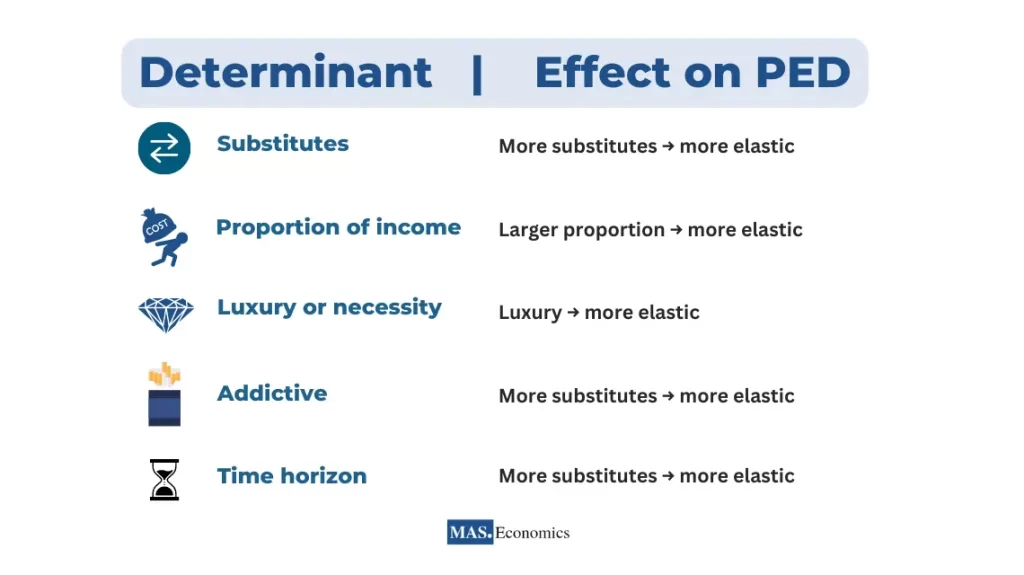
The availability of substitutes
Goods with many substitutes tend to have more elastic demand, as consumers can easily switch to other goods if the price of one good increases.
For example, if the price of gasoline increases, consumers can switch to public transportation, ride-sharing, or walking.
The time horizon
Elasticity can change over time. In the short run, demand and supply can be relatively inelastic, as businesses and consumers have less time to adjust to price changes. In the long run, elasticity tends to increase as businesses have more time to adjust their production and consumers have more time to find substitutes.
For example, if the price of gasoline increases, consumers may find alternative transportation options in the long run, but they may not be able to do so in the short run.
Necessity of the good
Necessities tend to have inelastic demand, as consumers need to purchase them regardless of the price. Luxuries tend to have more elastic demand, as consumers can choose without them if the price is too high.
For example, consumers need to buy food regardless of the price, so the demand for food is relatively inelastic. However, consumers may choose to forgo buying a new car if the price is too high, so car demand is relatively elastic.
Price of complements
Goods used together, like coffee and cream, are known as complements. It’s important to note that if the price of coffee increases, the demand for cream will inevitably decrease. Consumers are less likely to purchase cream if they shell out more money for coffee.
Income level
The demand for some goods, such as luxury goods, tends to be more elastic at higher income levels. This is because consumers at higher income levels have more money to spend on substitutes, so they are more likely to switch to other goods if the price of one good increases.
Applications of Price Elasticity of Demand
Governments, businesses, consumers, and researchers can all benefit from understanding the price elasticity of demand.
Governments
Governments can use PEDs to design tax policies and other interventions in the market.
- Design tax policies and other interventions in the market.
- Tax goods with inelastic demand to raise revenue.
- Tax goods with elastic demand to discourage consumption.
For example, if a government wants to raise revenue from taxes, it may tax goods with inelastic demand. Consumers will continue to buy these goods even if the price increases so that the government can collect more revenue. Conversely, if a government wants to discourage the consumption of a particular good, it may tax goods with elastic demand. This is because consumers will be more likely to switch to substitutes if the price of the good increases so that the government can reduce consumption.
Businesses
Businesses can use PEDs to set prices and make marketing decisions.
- Set prices and make marketing decisions.
- If demand is elastic, lower prices attract more customers.
- If demand is inelastic, raise prices to increase profits.
For example, if a business knows that the demand for its product is elastic, it may lower its price to attract more customers. Conversely, if a business knows that the demand for its product is inelastic, it may raise its price to increase its profits.
Consumers
Consumers can also use PEDs to make informed decisions about their purchases.
- Make informed decisions about their purchases.
- If demand is elastic, wait for a sale before making a purchase.
- If demand is inelastic, buy the good even if the price is high.
For example, if consumers know that the demand for a good is elastic, they may be more likely to wait for a sale before making a purchase. Conversely, if consumers know that the demand for a good is inelastic, they may be more likely to buy it even if the price is high.
Market researchers
- Understand the behavior of consumers.
- Develop marketing strategies that are more effective at influencing consumer behavior.
Cross-Price Elasticity of Demand
To accurately gauge the responsiveness of one good’s demand to changes in the price of another good, the cross-price elasticity of demand (XED) must be calculated. This calculation involves dividing the percentage change in quantity demanded of good A by the percentage change in the price of good B.
The formula for cross-price elasticity of demand is:
XED = \( \frac{\% \text{ change in quantity demanded of good A}}{\% \text{ change in price of good B}} \)
Consider two goods: smartphones (Good A) and phone cases (Good B). Suppose the price of smartphones increases by 15%, and as a result, the quantity demanded of phone cases decreases by 8%. In that case, we can use the formula for XED to calculate the elasticity as follows:
\[ XED = \frac{\% \text{ change in quantity demanded of Good B}}{\% \text{ change in price of Good A}} = \frac{-0.08}{0.15} = -0.53 \]
The negative value of XED indicates that smartphones and phone cases are complementary goods. An increase in the price of smartphones leads to a decrease in the demand for phone cases, showcasing their interdependency.
XED employs the sign of its value to reveal the nature of relationships between goods.
- Substitutes: Substitutes are like old friends, interchangeable. If one’s price rises, the demand for the substitute surges. For example, consumers may shift to ride-sharing services as a suitable substitute as gasoline prices climb.
- Complements: Complementary goods are inseparable partners. If the price of one rises, the demand for the other wanes. When gasoline prices surge, people might buy fewer cars because the higher fuel costs make driving less affordable.
Determinants of Cross-Price Elasticity of Demand
| Determinant | Explanation |
|---|---|
| Degree of substitutability | The more substitutable the goods are, the greater the XED will be. For example, the XED between butter and margarine is likely to be higher than the XED between butter and olive oil. |
| Time horizon | The XED can change over time. In the short run, consumers may not have time to adjust their consumption habits to changes in prices, so the XED may be smaller. In the long run, consumers have more time to adjust their consumption habits, so the XED may be larger. |
| Availability of substitutes | The more substitutes there are for a good, the greater the XED will be. For example, the XED for cars is likely to be higher than the XED for a specific brand of car. |

|
|
Applications of Cross-Price Elasticity of Demand
Pricing Strategy
The cross-price elasticity of Demand (XED) is vital for businesses in devising effective pricing strategies. A high XED implies that changes in the price of one product can significantly influence the demand for another. Businesses operating in this context must exercise caution when adjusting prices, as a change in the price of one item could inadvertently trigger a decrease in demand for a related product.
Strategic Marketing
XED also guides businesses in shaping their marketing approaches. With a high XED, businesses may find it beneficial to market complementary products together. Since altering the price of one product could impact the demand for another, aligning marketing efforts can boost overall consumer interest and engagement.
Policy-Making Considerations
Governments, too, harness XED to inform policy choices. In scenarios involving tax decisions on goods and services, XED comes into play. A high XED suggests that a tax increase on one item could trigger a decrease in demand for another, compelling governments to balance taxation strategies.
Application in Practice
Imagine a business specializing in coffee and tea sales. Recognizing a high XED between coffee and tea, a price change will significantly impact tea’s demand. To optimize profits, the business may contemplate increasing coffee prices. However, it must tread carefully, avoiding excessive hikes that could lead to decreased demand for tea and diminished profits.
Income Elasticity of Demand
YED, or income elasticity of demand, determines the level of responsiveness of a good’s demand to fluctuations in income. The calculation involves dividing the percentage change in quantity demanded by the percentage change in income.
The formula for income elasticity of demand is:
YED = \( \frac{\% \text{ change in quantity demanded}}{\% \text{ change in income}} \)
Imagine a scenario where the income of consumers in a particular region increases by 10%. As a result, the quantity demanded of luxury cars rises from 500 units to 600 units. Using the formula for YED, we can calculate the elasticity as follows:
\[ YED = \frac{\% \text{ change in quantity demanded}}{\% \text{ change in income}} = \frac{(600 – 500)/500}{0.10} = 2.00 \]
The positive value of YED indicates that luxury cars are a normal good. As income increases, the demand for luxury cars also increases, and the quantity demanded is relatively responsive to changes in income.
With its sign, YED illuminates the nature of goods in the context of income changes.
- Necessities: Necessities are life’s anchors; they remain stable as income fluctuates. Take food and housing—essential for survival—where the demand doesn’t waver much regardless of income changes.
- Luxuries: The luxury parade marches to a different beat. Demand for luxuries dances with income variations, soaring beyond proportionality. Think vacations and jewelry—not vital for survival but more attainable as income grows.
- Normal Goods: Normal goods thrive on prosperity. As income increases, demand swells, but the extent varies. The demand hike can be moderate or substantial, depending on the specific good.
Determinants of Income Elasticity of Demand
| Determinant | Explanation |
|---|---|
| Type of good | Normal goods have a positive YED, while inferior goods have a negative YED. For example, the YED for steak is likely to be positive, while the YED for ramen noodles is likely to be negative. |
| Stage of the life cycle | The YED of a good can also vary depending on the stage of the life cycle. For example, young adults tend to have a higher YED for housing than older adults. |
| Price of the good | The YED of a good can also be affected by the price of the good. For example, the YED of a good with a high price may be lower than the YED of a good with a low price. |

|
|
Applications of Income Elasticity of Demand
Pricing Strategy
Income Elasticity of Demand (YED) is a pivotal tool for businesses when setting prices. A high YED signifies that changes in income can substantially influence a product’s demand. Consequently, businesses must exercise prudence when determining prices, as shifts in income could inadvertently trigger a decrease in consumer demand for their products.
Strategic Marketing
YED also guides businesses in crafting strategic marketing plans. With a high YED, businesses may tailor their marketing efforts toward specific income segments. This is driven by the understanding that income fluctuations can lead to varying demand for their products across different income groups.
Policy-Making Implications
Governments, too, leverage YED to inform policy decisions. In cases involving taxation strategies for goods and services, YED plays a role. When YED is high, a tax hike on a product can decrease demand among low-income households, prompting governments to weigh their tax policies thoughtfully.
Application in Practice
Consider a business specializing in luxury goods. Recognizing a high YED for luxury items, changes in income significantly affect the demand for these goods. To enhance profitability, the business might contemplate adjusting prices during periods of economic growth when incomes are rising. Yet, the business must exercise caution, avoiding excessively steep price hikes that could dampen demand, even among high-income consumers.
Price Elasticity of Supply
The calculation of price elasticity of supply (PES) determines the level of responsiveness of the quantity supplied of a good concerning the changes made in its price. PES is obtained by dividing the percentage change in quantity supplied by the percentage change in price.
To illustrate the difference between elastic and inelastic supply, let’s look at the following graph.
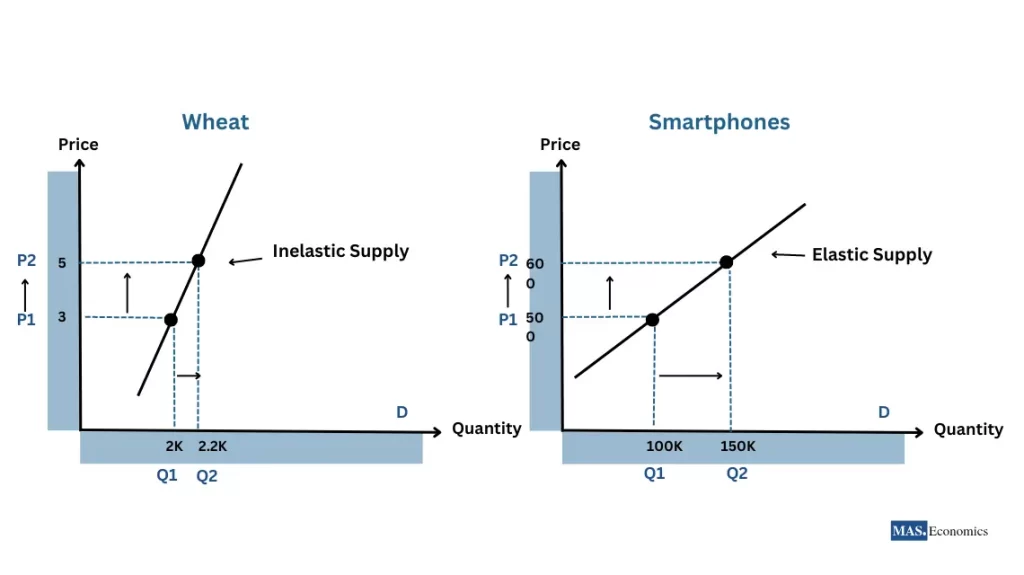
Elastic supply graphs have a relatively steep slope, meaning that a slight price change leads to a significant change in the quantity supplied. This is because businesses can quickly increase production in response to a price increase.
Inelastic supply graphs have a relatively shallow slope, which means that a slight change in price leads to a small change in the quantity supplied. This is because businesses cannot quickly increase production due to a price increase.
The formula for price elasticity of supply is:
PES = \( \frac{\% \text{ change in quantity supplied}}{\% \text{ change in price}} \)
Suppose an agricultural market where wheat prices increase from $5 to $7 per bushel due to a poor harvest. As a result, the quantity supplied increased from 2,000 bushels to 2,200 bushels.
We can calculate the price elasticity of supply (PES) as follows:
\[ PES = \frac{\% \text{ change in quantity supplied}}{\% \text{ change in price}} = \frac{(2200 – 2000)/2000}{(7 – 5)/5} = 0.5 \]
The positive value of PES indicates that the supply of wheat is inelastic. This means that suppliers are less responsive to price changes, and the percentage change in quantity supplied is proportionally smaller than the percentage change in price.
In this case, the price increase of $2 per bushel led to an increase in quantity supplied of only 200 bushels. This is because wheat farmers cannot increase production in the short term. They may need to wait for the next growing season to plant more wheat, or they may need to find new wheat sources.
Now, let’s consider the market for smartphones. Suppose there’s a sudden surge in smartphone demand due to the release of new, innovative models. Manufacturers in the smartphone industry typically can increase production significantly within a short period. This increase in production doesn’t require major changes in production processes or resource allocation.
Suppose the price of smartphones rises from $500 to $600, resulting in a rise in quantity supplied from 100,000 units to 150,000 units.
We can calculate the PES as follows:
[ PES = \frac{\% \text{ change in quantity supplied}}{\% \text{ change in price}} = \frac{(150,000 – 100,000)/100,000}{(600 – 500)/500} = 2.0 ]
The positive value of PES (equal to 2.0) signifies an elastic supply. This means that manufacturers can swiftly adjust their production levels to respond to changes in price, accommodating shifts in consumer demand. This elasticity allows suppliers to be agile in their response to market dynamics, as they can quickly ramp up or down production in line with price changes.
In this case, the price increase of $100 per smartphone increased the quantity supplied of 50,000 units. This is because smartphone manufacturers can increase production by using existing resources more efficiently or investing in new production capacity.
Determinants of price elasticity of supply
| Determinant | Explanation |
|---|---|
| Degree of specialization | The more specialized a firm is, the less elastic its supply will be. This is because a specialized firm is more likely to have higher Fixed Costs, which makes it more difficult for the firm to adjust its output in response to price changes. |
| Time horizon | The PES can change over time. In the short run, firms may not have time to adjust their production capacity to changes in prices, so the PES may be smaller. In the long run, firms have more time to adjust their production capacity, so the PES may be larger. |
| Availability of inputs | The more easily available inputs are, the more elastic the supply will be. This is because firms will be able to more easily increase their output in response to price increases if they have ready access to inputs. |

|
|
Applications of Price Elasticity of Supply
Pricing Strategy
Price Elasticity of Supply (PES) is crucial in guiding businesses as they make pricing decisions. When PES is high, businesses tread cautiously when adjusting prices, understanding that even a minor price change can result in a substantial profit decrease. Conversely, when PES is low, businesses enjoy more flexibility in setting prices to maximize their competitive advantage.
Production Planning
Businesses also rely on PES to determine their production levels effectively. With a high PES, they may produce fewer units to prevent oversupply. Conversely, businesses might ramp up production when PES is low to satisfy consumer demand.
Influencing Government Policies
Governments, too, harness PES to shape their policy choices. For instance, in decisions involving subsidies for farmers, PES comes into play. A high PES suggests that a subsidy would significantly increase supply. This, in turn, could alleviate food prices, making essential goods more accessible to consumers.
Application in Practice
Imagine a business specializing in banana sales. Recognizing that bananas have a high PES, even slight price adjustments can lead to substantial shifts in supply. If the business seeks enhanced profitability, it may contemplate raising prices. Yet, caution must prevail to avoid excessive hikes that could dampen demand and reduce profits.
Conclusion
Elasticity measures how the demand or supply of a product reacts to price, income, or other changes, aiding businesses and policymakers in pricing, production, and taxation decisions. It encompasses price elasticity of demand (PED), cross-price elasticity of demand (XED), and income elasticity of demand (YED).
By understanding these elasticities, businesses and policymakers can optimize strategies for economic betterment.
Key takeaways include:
- Elasticity varies based on product specifics, time, and context.
- It guides optimal pricing, taxation, and marketing choices.
- More excellent elasticity means sharper demand or supply responsiveness to price changes.
- Elasticity equips decision-makers with a potent tool for wiser economic choices.
Thanks for reading! If you enjoyed this series, spread the knowledge by sharing it with friends and on social media.
Happy learning with MASEconomics!
